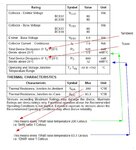andro
Junior Member level 3
I am a little confused when should i use heat sink or not using it.
For example if i want to design power amplifier or control servo motor and i use power transistor, and if transistor runs at IC = 1 A and VCE=10 V the power dissipation = 10 W . So how to know if that transistor needs heat sink or not ?
i need an example and steps to know if my design requires heat sink or not
Thank you
For example if i want to design power amplifier or control servo motor and i use power transistor, and if transistor runs at IC = 1 A and VCE=10 V the power dissipation = 10 W . So how to know if that transistor needs heat sink or not ?
i need an example and steps to know if my design requires heat sink or not
Thank you
